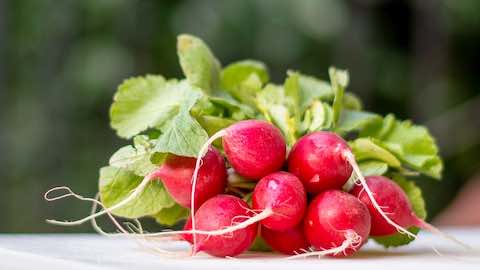- MENU
- HOME
- SEARCH
- WORLD
- MAIN
- AFRICA
- ASIA
- BALKANS
- EUROPE
- LATIN AMERICA
- MIDDLE EAST
- United Kingdom
- United States
- Argentina
- Australia
- Austria
- Benelux
- Brazil
- Canada
- China
- France
- Germany
- Greece
- Hungary
- India
- Indonesia
- Ireland
- Israel
- Italy
- Japan
- Korea
- Mexico
- New Zealand
- Pakistan
- Philippines
- Poland
- Russia
- South Africa
- Spain
- Taiwan
- Turkey
- USA
- BUSINESS
- WEALTH
- STOCKS
- TECH
- HEALTH
- LIFESTYLE
- ENTERTAINMENT
- SPORTS
- RSS
- iHaveNet.com: Recipes

Sauteed Radishes
By Sharon Palmer, R.D.
Radishes were first grown thousands of years ago in ancient China, Egypt and Greece. This spicy, colorful vegetable soon conquered the world, becoming beloved in many cultures from Japan to France. Radishes were so highly regarded in ancient Greece that gold replicas were made of them. The Greek name for the radish genus, Raphanus, means "quickly appearing," which perfectly describes their reputation for being the first vegetable to sprout in a spring garden. Radishes were used in traditional Asian medicine for ailments such as whooping cough, cancer, gastric problems, constipation, arthritis and parasites.
Part of the Brassica family (also known as the mustard or cabbage family), radishes (Raphanus sativus) are edible roots that come in an astonishing variety of colors, shapes and sizes. Though most people equate the radish with the most popular variety in the U.S., the Red Globe, radishes can be pink, white, gray-black, purple or yellow, and have long turnip-like roots. Radishes are naturally low in calories, yet they contain rich supplies of dietary fiber, vitamin C, folate and potassium. Their pungent flavor is due to plant compounds called glucosinolates, which are also found in mustard, horseradish and wasabi.
Research indicates that glucosinolates may have cancer-fighting potential, and that eating Brassica vegetables helps protect against rectal and colon cancer. These vegetables aid in the detoxification of carcinogens and enhance the activity of several liver enzymes that are part of the body's natural detoxification system. Radishes also contain powerful antioxidants called anthocyanidins -- compounds that lend radishes their vivid color and protect against cancer and heart disease. Researchers from India found that radish consumption may reduce the risk of gallbladder cancer by 60 percent.
To prepare radishes, select those that are firm and brightly colored, trim tops and ends, and scrub -- but don't peel them; flavor and nutrients reside in their skins. Venture into the radish world by trying new varieties such as Daikon, an Asian radish that's a cross between a white carrot and turnip, or Black Spanish radishes, which boast spicy, white flesh beneath black skin. Frequently, people reserve radishes as a garnish (think of radish roses), but a new culinary trend finds chefs showcasing the peppery flavor of radishes on the menu. You probably know that the crisp texture and jewel tones of raw radishes suit slaws, salads and vegetable platters perfectly, but did you know they are equally delicious cooked? Saute radishes with fresh herbs, add them to soups and casseroles or stir-fry them. If you're looking for a truly spectacular way to enjoy radishes, try this eye-opening Dutch breakfast: Slice radishes onto lightly buttered bread and bite in.
Radishes - Notable Nutrients
(1 cup, sliced)
Calories: 19
Vitamin C: 17.2 milligrams (29 percent DV)
Folate: 29 micrograms (7 percent DV)
Potassium: 270 milligrams (8 percent DV)
Dietary Fiber: 2 grams (7 percent DV)
DV = Daily Value
Sauteed Radishes Recipe
Serves 6.
1 tablespoon olive oil
1/4 cup water
2 bunches fresh radishes, tops trimmed, quartered (about 1 to 1 1/2 pounds)
1/4 teaspoon black pepper
1 tablespoon chopped fresh dill
Heat olive oil and water in saute pan over medium-high heat. Add radishes and pepper.
Saute radishes, stirring often, until they begin to brown and are crisp-tender (about 8 minutes.)
Sprinkle with fresh dill and serve immediately.
Nutrition Information per Serving: 38 calories, 1 gram (g) protein, 4 g carbohydrates,
2 g fat, less than 0.5 g saturated fat, 2 g dietary fiber, 4 milligrams sodium.
Subscribe to Receive our Gourmet Recipes
FOOD, DRINK & RECIPES [...]
APPETIZERS | SOUPS | PASTA | SALADS | MAIN COURSES | SEAFOOD | CHICKEN | PORK | LAMB | BEEF / VEAL | VEGETARIAN | SIDE DISHES | DESSERT | HEALTHY | WOLFGANG PUCK
Article: Copyright © Tribune Media Services, Inc.
Recipes: "Sauteed Radishes Recipe
World-renowned chefs with an extraordinary passion for food share their passion on iHaveNet.com. These chefs make great cooking easier than imagined. Each gourmet recipe features expert advice and an easy-to-make recipe. Exactly what you need to transform your home cooking from acceptable to delectable